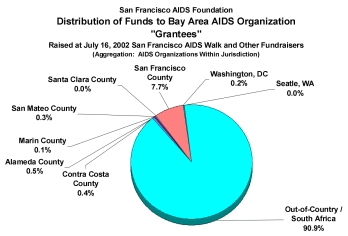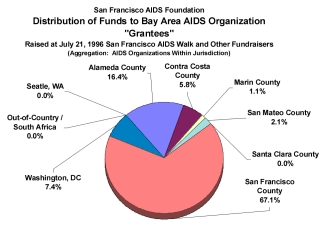Go to: TheLastWatch.com's coverage of the San Francisco AIDS Foundation
| How to
Keep AIDS Walk Funds in the Bay Area July 11, 2004 by Patrick Monette-Shaw |
|
| . | |
|
Promotional material for the 2004 AIDS Walk invites you to “change the course of the epidemic.” TheLastWatch.com challenges you to also help change the course in how AIDS Walk funds are more equitably shared with smaller AIDS Service Organizations in the Bay Area. Here’s how you can change the course of sharing funds fairly. The San Francisco AIDS Foundation uses the “grantee” model when it shares funds with smaller AIDS Service Organizations (ASO’s) in the Bay Area that are raised at various fundraising events. SFAF contracts with the Tides Foundation to award “grants” to smaller AIDS organizations. An alternative method of sharing revenue is referred to as the “beneficiary model,” which affords “beneficiary” organizations some control in how the funds raised are divided up among event “partners,” and provides for some control over fundraising events’ overhead expenses; true “beneficiaries” do not have to rely on the capriciousness of “grants.” When SFAF duked it out with Palotta Teamworks fighting for control over the California AIDS Ride, SFAF marched into court, and its Executive Director, Pat Christen, testified, convincing the judge that SFAF deserved control of the AIDS Ride because Palotta had forced SFAF to be a “grantee” rather than a full partner using the beneficiary model. The dirty little secret, however, is that SFAF is unwilling to admit that what is good for the goose is good for the gander. SFAF wants to have it both ways: It wants the beneficiary model applied to itself, but it is unwilling to allow smaller ASO’s participating in the AIDS Walk to use the beneficiary model, forcing them into the grantee model, instead. By insisting on this double-standard, SFAF retains control over how money from the AIDS Walk and other fundraising events is distributed. As you can see in Figure 1 below, according to its tax return for the period ending in June 2003, SFAF had increased the amount of “grants paid” to its global affiliate, the Pangaea Global AIDS Foundation (at which organization Pat Christen is simultaneously its president) to 91% of the grants it reported to the IRS it had made. Of the $9,032,282 SFAF reported to the IRS it had shared in its “grantmaking” awards for the period ending in June 2003, $8.2 million of it went to Pangaea, up from the $5.9 million it had awarded to Pangaea as “grants paid” in the period ending in June 2002 (both amounts exclude additional millions in grants remaining payable to Pangaea ending in 2002 and 2003, and also exclude both grants paid + grants payable to Pangaea that my have been made during the period July 2003–June 2004). At the same time, many of the smaller ASO’s in the surrounding Bay Area saw their grant awards reduced, or eliminated between 2002 and 2003.  For instance, Project Inform, located in San Francisco County, saw its 2002 grant of $120,000 shrivel to just $2,500 in 2003. The AIDS Emergency Fund — which awards emergency direct financial assistance to people with HIV/AIDS — also located in San Francisco County, saw its award shrink by half, from $50,000 to $25,000 across the two fiscal years. The Larkin Street Youth Center saw its $12,500 award in 2002 reduced to nothing in 2003; another San Francisco County ASO, the Black Coalition on AIDS, also saw its 2002 grant of $15,000 reduced to zero in 2003. Switching to Alameda County — which had received 16.4% of the funds distributed from AIDS Walk 1996 as shown in Figure 2, but has dropped to only 0.5% of the awards shown in Figure 1 — Women Organized to Respond to Life-Threatening Diseases (WORLD), saw its award plummet by $20,000, down to $15,000 from the 2002 award of $35,000. As well, the HIV Education and Prevention Project of Alameda County saw its $57,500 award in 2002 reduced to zero in 2003. In Oakland, which is also in Alameda County, La Clinica de La Raza/Fruitvale Health Project has not received AIDS Walk funds since it last received a grant from the July 18, 1999 AIDS Walk.  Over in Contra Costa County, the AIDS Community Network in Richmond saw its 2002 award of $15,000 also reduced to zero in 2003, while over in Marin County, the Marin AIDS Project saw its 45,000 award in 2002 reduced to just $5,000 in 2003. The AIDS Prevention Action Network, located in Redwood City in San Mateo County, saw its 2002 award of $48,253 reduced to zero in 2003. Table 1 summarizes the amount of funds awarded to various ASO’s by county. For a detailed list of each ASO by county, please refer to the attached PDF file. Table 1 (Shows only “grants
paid,” not “grants payable.” Source: SFAF
IRS Tax Returns available 7/11/2004. According to a November 18 New York Times article, SFAF “… diverted $1 million of its money to help establish Pangaea, an affiliate with its own board and Ms. Christen as president.” The $1 million diversion is not substantiated, however. According to the PriceWaterhouseCoopers audited report dated October 2002, SFAF provided grants to Pangaea totaling $5.92 million, in addition to having grants payable to Pangaea at the end of June 2002 of $2.86 million. Between “grants paid,” and grants remaining payable to, SFAF sent Pangaea a total $8.78 million just for the period July 2001–June 2002, and shipped another $13.6 to Pangaea between grants paid + grants payable for the period July 2002–June 2003, leaving Bay AREA ASO’s high and dry. Across the two reporting periods, SFAF has sent a total of $22.4 million to Pangaea between grants paid + grants payable. The Times article further reported that “Ms. Christen said some people at the foundation were wary about telling donors that money was being spent overseas. ‘But we’ve always been very honest with our donors about what we do with our resources,’ she said.” This is completely untrue; first, the Times article indicated that SFAF anticipated using no more than 25% of funds raised at its various fundraising events for its global operations, but clearly, 91% of the 2002 “grants paid” funds were sent to Africa (and that was only grants paid, not grants payable), not 25%. Second, SFAF has not been honest with its donors, any more than it is now being “honest” with the Bay Area Reporter or SFAF’s Bay Area clients. Various SFAF fundraising promotional materials I have accumulated have not told people registering for its AIDS Walk, its new LifeCycle or its old California AIDS Ride, nor its AIDS Marathon that the lions share of funds raised would be sent overseas. SFAF’s pre-event come-ons always promise: “Come walk/ride/marathon with us; your efforts will assist 36 Bay Area beneficiary organizations helping people living with HIV/AIDS in the Bay Area.” Not other promises. And SFAF’s promotional materials have certainly not told the truth that smaller Bay Area ASO’s would see their share of the pie reduced to 9% of the total — so that 91% could be diverted to Africa. Ironically, the San Francisco AIDS Foundation (SFAF) has chosen to use the upside-down AIDS ribbon — a symbol to raise awareness of the need for an AIDS vaccine — in the 2004 AIDS Walk’s tag line and advertising collateral. The irony rests in the fact that over the past eight years, SFAF has donated a miserly $45,000 for vaccine development from the more than $25 million raised at AIDS Walk. So much for SFAF’s commitment to funding for an AIDS vaccine. A further irony is that the course of funds shared with beneficiary organizations has shifted from the Bay Area to Africa, so it is no small irony that the imagery for this year's AIDS Walk shows the Golden Gate Bridge heading out of the county. Indeed, in years past SFAF has listed the names of up to 36 Bay Area AIDS organizations who were to have been “beneficiaries” of funds raised at AIDS Walk San Francisco; this year’s promotional material lists not one Bay Area organization, only citing that “dozens of AIDS service organizations throughout the Bay Area” will receive financial support from the AIDS Walk (how many dozens are not specified). SFAF’s promotional materials for AIDS Walk 2004 also fail to mention that the lion's share of funds raised will, more than likely, again go to Africa, not to Bay Area AIDS organizations serving people living with HIV/AIDS in our own back yards in Bay Area counties. Concerned that AIDS Walk funds were not being shared equitably with smaller ASO’s, I sponsored a co-worker for the July 15, 2001 AIDS Walk, but made out my two checks to the AIDS Emergency Fund and the Breast Cancer Emergency Fund. Despite my co-worker’s best efforts to ensure my checks would receive special treatment as “restricted funds” earmarked for organizations of my choice, both checks were cashed instead by SFAF’s AIDS Walk “receiving account” at the Bank of America! The Bay Area is facing massive federal, state, and city AIDS service cuts. If you want to ensure that AIDS Walk funds remain in the Bay Area, endorse AIDS Walk checks payable to your favorite Bay Area AIDS organization, not to “AIDS Walk” or “SFAF.” Then, mail your contributions directly to the organization you make your checks out to. If you turn in your donations at the AIDS Walk, your favorite organization may not see a dime of your donations. Following these two recommendations, you can help change the course of how AIDS Walk funds are more equitably shared with Bay Area ASO’s. --- |
|
_______
Copyright (c) 2004 by Patrick Monette-Shaw. All rights reserved.
This work may not be reposted anywhere on the Web, or reprinted
in any print media, without express written permission of the
author. E-mail him at pmonette-shaw@earthlink.net.